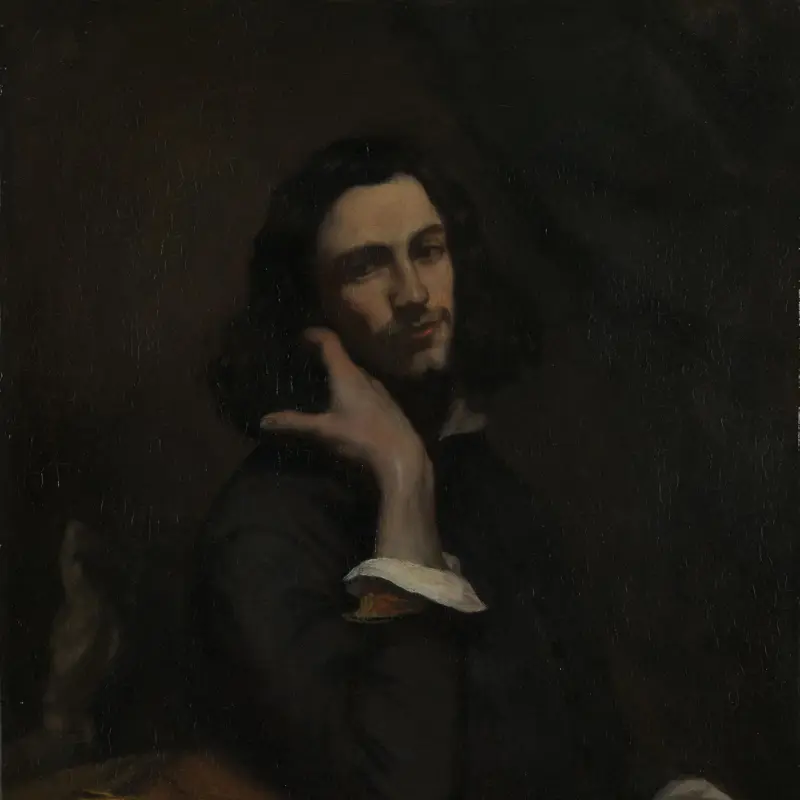Possibly after Gustave Courbet, 'Young Ladies on the Banks of the Seine (Summer)', possibly 1870s
About the work
Overview
Two young women lie by a river. Traditionally, such a scene would be set in an idyllic landscape, with the women as impossibly perfect ideals of youth and beauty, often in the guise of classical nudes – goddesses of Greek mythology. But this pair caused a scandal when a larger version (now in the Musée du Petit Palais, Paris) appeared at the Paris Salon in 1857.
Courbet had subverted the tradition, showing two modern city women in an inappropriate Arcadian setting, one of them, shockingly, in her underwear. To the contemporary bourgeois audience, full nudity would probably have been considered less indecent. The artist’s reputation as a dangerous radical quickly grew.
Courbet made a number of studies for the Salon painting, but it’s not certain if this is one of them or a copy made later by an unknown artist. It would not appear to be in Courbet’s hand, but still holds something of the shock of the original at first view.
Key facts
Details
- Full title
- Young Ladies on the Banks of the Seine (Summer)
- Artist
- Possibly after Gustave Courbet
- Artist dates
- 1819 - 1877
- Date made
- possibly 1870s
- Medium and support
- oil on canvas
- Dimensions
- 96.5 × 130 cm
- Acquisition credit
- Bought, 1964
- Inventory number
- NG6355
- Location
- Not on display
- Collection
- Main Collection
Provenance
After Courbet’s death NG 6355 entered the collection of Juliette Courbet (1831–1915), sister of the artist; inherited by two friends whom she nominated her heiresses, Marie‐Louise de Tastes and Félice Lapierre; sold by Marie‐Louise de Tastes to Bernheim‐Jeune, 8 September 1915, their number 20.487, cliché no. 973; sold by them on 5 October 1915 to Denys Cochin (1851–1922), a writer and member of French parliament; bought back from him by Bernheim‐Jeune, 4 January 1917, and sold to the dealer Walther Halvorsen, 28 February 1917 for the Norwegian ship owner Jørgen Breder Stang (1874–1950), Kristiania.
In the 1920s the dealer and gallery owner Alfred Gold (1874–1958), who had a close relationship with Stang, was selling pictures from his collection and perhaps had NG 6355 on commission (it was included in exhibitions held at his gallery, see Gold 1930), but being unable to sell it, returned it to Stang. The Seligmann papers contain a number of letters from Gold to Germain Seligmann regarding the Stang collection, in particular one dated 22 January 1929 regarding Stang’s reductions in price on certain paintings, ‘Manet, Courbet, Corot et peut‐être aussi Renoir’ and a further dated 24 January 1929 stating that he will give a commission of 5 per cent on the paintings that he will have on consignment from Stang. It was in Stang’s collection during and after the Second World War and was given at some point by Stang to his daughter Annie Bergh (1906–1975), or inherited by her on his death, but left her collection at some point between 1957 and 1964; anonymous sale, Sotheby’s, 1 July 1964, lot 75a, where purchased by the National Gallery (Grant‐in‐Aid with a Special Grant and an anonymous contribution).
Additional information
Text extracted from the ‘Provenance’ section of the catalogue entry in Sarah Herring, ‘National Gallery Catalogues: The Nineteenth Century French Paintings’, vol. 1, ‘The Barbizon School’, London 2019; for further information, see the full catalogue entry.
Exhibition history
-
2014Gustave Courbet. Les années suissesMusée Rath5 September 2014 - 4 January 2015
Bibliography
-
1906G. Riat, Gustave Courbet: Peintre, Paris 1906
-
1923Föreningen fransk konst, Gustave Courbet, Honoré Daumier, Constantin Guys, Sweden 1923
-
1924R. Hoppe, 'Courbet and His Work in the National Museum (stockholm) and the Northern Collections', Nationalmusei Årsbok, 6, 1924, pp. 16-48
-
1929C. Léger, Courbet, Paris 1929
-
1929C. Gronkowski, 'L'Exposition Gustave Courbet au Petit Palais', Gazette des beaux-arts, II, 1929
-
1930C. Léger, Ausstellung Gustave Courbet (exh. cat., Galerie Wertheim, Berlin), Berlin 1930
-
1951G. Mack, Gustave Courbet, Westport, Connecticut 1951
-
1957S. Kahn and M. Ecalle, 'Les Demoiselles des Bords de la Seine', Bulletin des amis de Gustave Courbet, 19, Ornans 1957
-
1965The National Gallery, The National Gallery: June 1962 - December 1964, London 1965
-
1970Davies, Martin, and Cecil Gould, National Gallery Catalogues: French School: Early 19th Century, Impressionists, Post-Impressionists etc., London 1970
-
1977R. Fernier, La vie et l'oeuvre de Gustave Courbet: Catalogue raisonné, 2 vols, Paris 1977
-
1978H. Toussaint et al., Gustave Courbet 1819-1877 (exh. cat., Royal Academy of Arts, London), London 1978
-
1988S. Faunce and L. Nochlin, Courbet Reconsidered, (exh. cat. Brooklyn Museum, 4 November 1988 - 16 January 1989), New York 1988
-
1991K. Herding, Courbet: To Venture Independent, New Haven 1991
-
2001
C. Baker and T. Henry, The National Gallery: Complete Illustrated Catalogue, London 2001
-
2004A. Holleczek et al, Französische Kunst, deutsche Perspektiven, 1870-1945: Quellen und Kommentare zur Kunstkritik, Berlin 2004
-
2019Herring, Sarah, National Gallery Catalogues: The Nineteenth Century French Paintings, 1, The Barbizon School, London 2019
About this record
If you know more about this work or have spotted an error, please contact us. Please note that exhibition histories are listed from 2009 onwards. Bibliographies may not be complete; more comprehensive information is available in the National Gallery Library.








